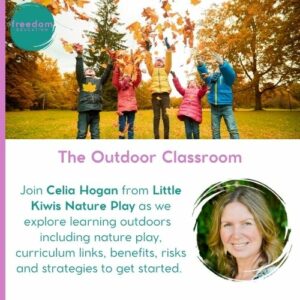
Not all classrooms have walls
Growing up a kiwi kid at a country school my memories of learning in the outdoors are plentiful. From hut building in the bush to making bridges across the creek. Games with sticks, and mud slides down the hill. Fond memories for sure.
Fast forward to my years as a teacher and I am disappointed to say I have not given my learners as much of these same opportunities. This is most certainly not through lack of wanting too but more so due to reasons that I am sure other teachers would resonate with.
- Lack of time due to so much curriculum content to cover.
- Lack of outdoor spaces beyond the concrete court, over crowded field and purpose built playground.
I know for some it could be due to fear of risky play, feeling out of their own comfort zone or not feeling they would be supported by their school.


So what can we do? Let’s not dwell on what we haven’t done but instead let’s focus on what we will do to get our kids outdoors more and to get the kiwi kid experience that I loved and enjoyed.
Research shows that the frontal cortex, which is responsible for controlling emotions and problem solving, is activated during play. This is what makes Celia Hogan of Little Kiwis Nature Play say “play makes children smarter” and I agree.
Cool so it’s good that we let kids play during lunchtime at school yeah? Yeah it is but what else could we do. What could we do as part of “class time”?
I get it, the idea of fitting in “outdoor learning” is daunting in terms of time, effort, risk, procedure and school politics. While you work on challenging or ignoring those things let’s look at some ideas to simply take inside learning outside.
- Reading a shared class novel/story? Take it outside! Sit under a tree, in a tree, on the field, on the deck – anywhere.
- Running a group teaching session or workshop? Take it outside! Those little whiteboards can go outside, so can your modelling books. What about chairs? Your kids will love sitting on the ground and so might you.
- Independent learning? Take it outside! Discuss a boundary if you need to with your class, ask them to pick themselves a spot and go for it. They can take their workbooks, pencil case, hell even a cushion if they feel the need.
- Digital learning? Take it outside! iPads and Chromebooks are made portable for a reason. They aren’t tied to desks or even tied to inside. Occasionally the sun will make it tricky to see the screen but that is nothing changing positions won’t fix.

If you are after a bit more, as in inside learning tasks adapted to make use of the outdoors give these a try.
- Use chalk on the ground for phonics, spelling, adjectives, counting. Why not write some inspirational messages while you are at it for students and staff once break time starts.
- Designate areas (of a space) to different answers and have students move there following a question. Eg. Is this a simple, compound or complex sentence? or possible answers to a math question.
- Identify and take photos of shapes in the outdoors. There are so many triangles, circles, pentagons etc in school playgrounds. Identify them and record a short video explaining what makes the item that shape “This is a square as it has 4 sides that are equal length”.
- Make shapes using sticks or human bodies.
- Measure things. Real things like the length of the court, the height of the slide. The time taken to run around the field.
I ask you this – What do you currently do inside that you CAN’T do outside? Probably not a lot. Maybe the odd thing requiring power. So what are you waiting for? Pick one part of your learning programme and try it outside tomorrow.
If you want to go even further and rethink education with an outdoor classroom lens then our freedom ed membership has an extensive spotlight chat with Celia Hogan. Celia shares with us more about the what, why and how or learning outdoors. We explore the barriers, how to overcome these as well as take a look at a couple of examples of just what learning can happen in the outdoors. We look more at moving past taking learning outside and actually using the outdoors as the learning. If you aren’t already, join as a member here.







